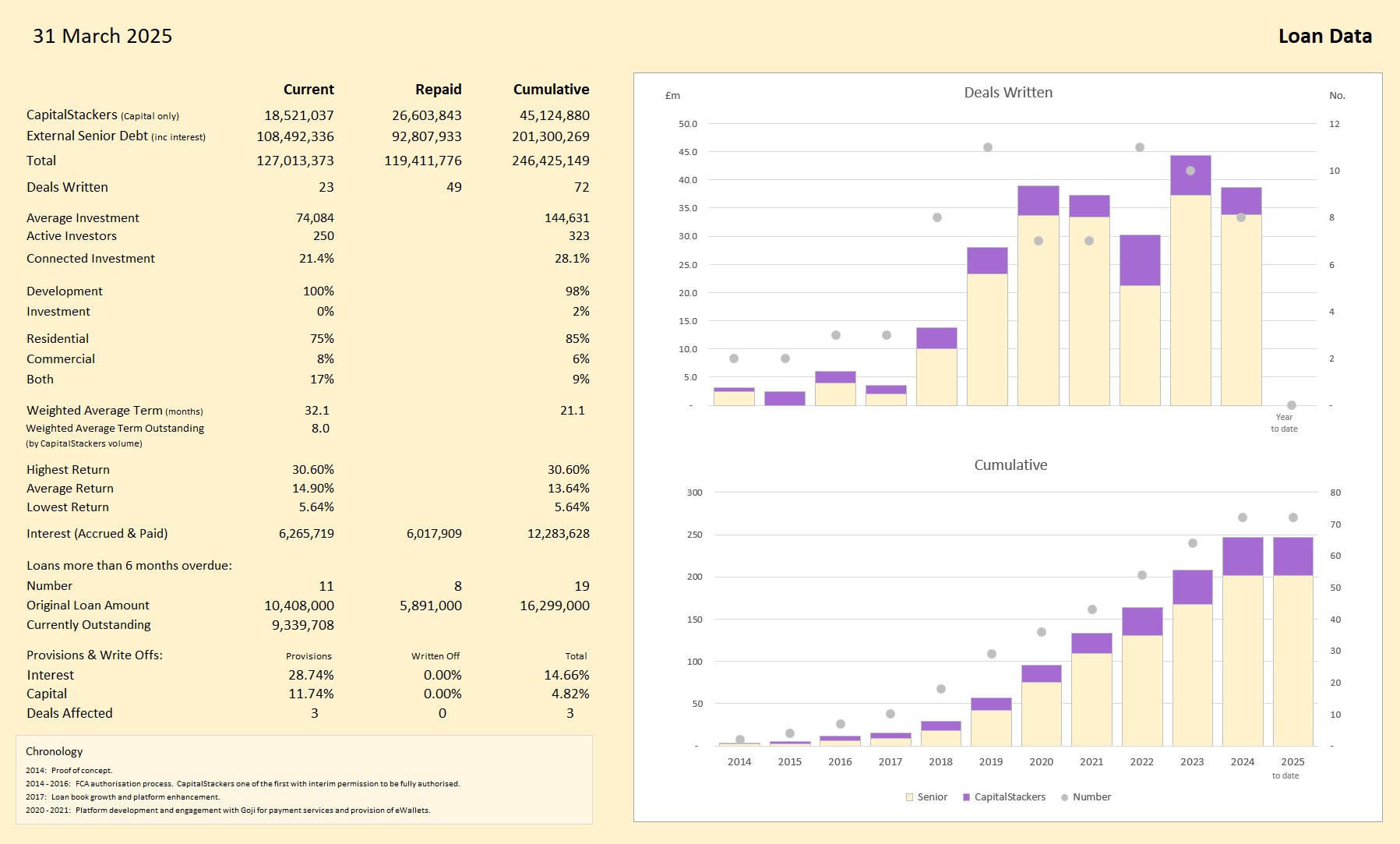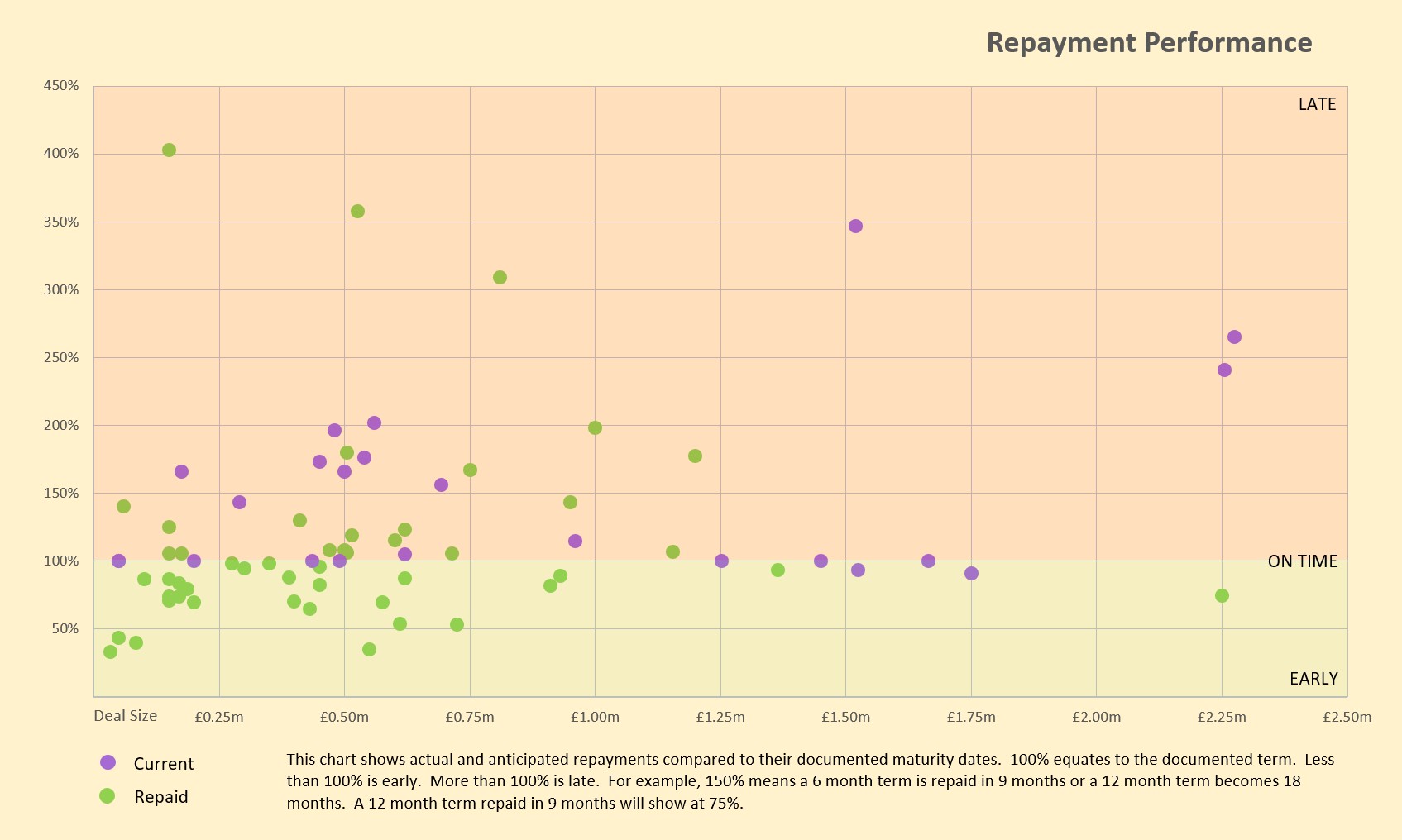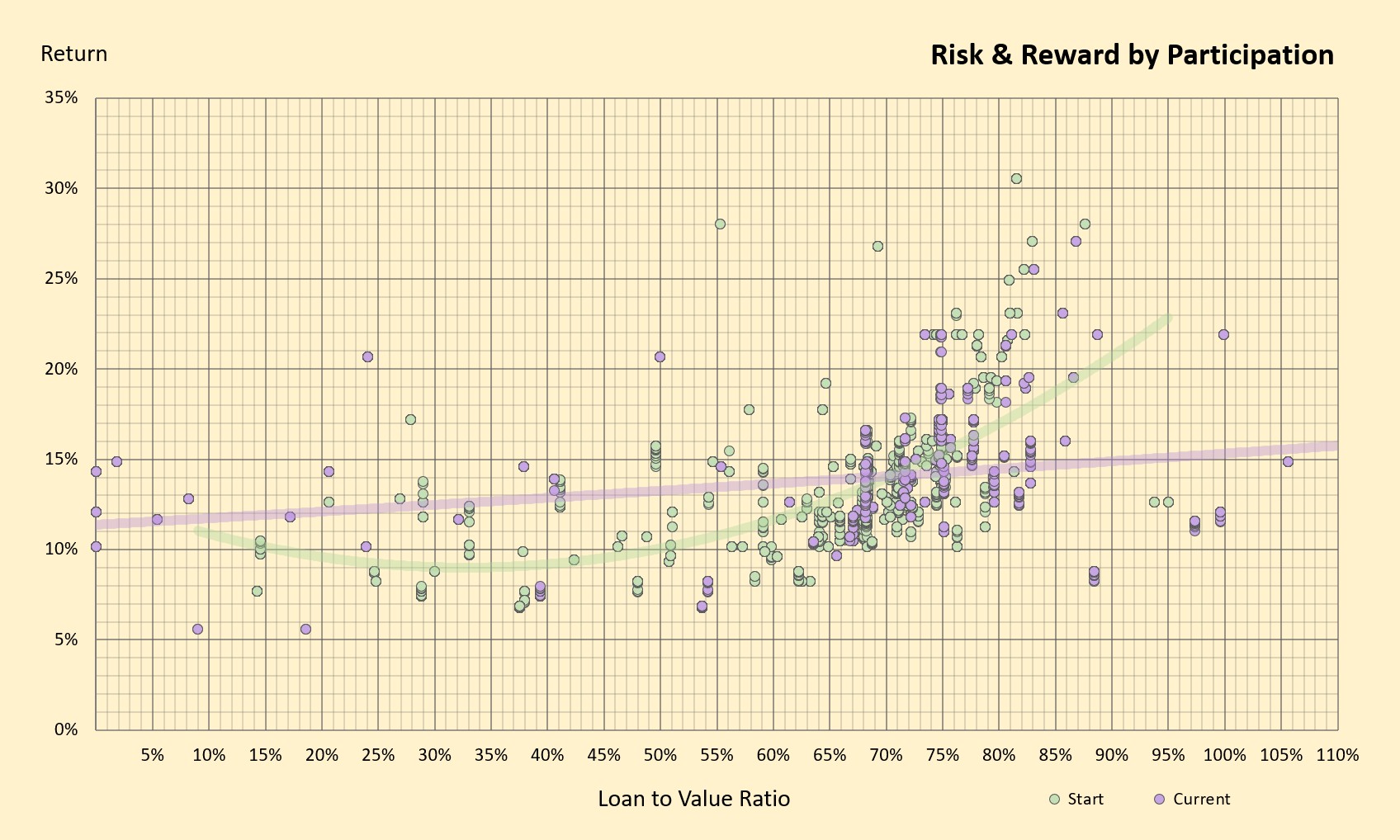Portfolio statistics
Here you can see the underlying information regarding deals that have been supported by CapitalStackers so far.
We work with banks to mitigate liquidity risk and make funding safer for you and the borrower. This collaborative arrangement brings all round mutual benefits, and also makes the process smoother and more efficient.
Loan data

In the above charts, the purple sections show cash provided by our investors, and the lighter areas the funding raised through banks. Combined together, this funding enables developers to get projects off the ground that would otherwise never have been built.
The “Average Investment” reflects the appetite of some of our larger investors and disguises to some extent the fact that we have numerous smaller investors lending at, or marginally above, our minimum £500 secondary market threshold. “Connected Investment” is that proportion of CapitalStackers’ lending provided by our directors and their close family. We have invested in every scheme alongside you and feel it may give you comfort to know we also have ‘skin in the game’.
Compared to property investment lending, it’s important to understand that the risk profile for development finance is higher with construction and exit risks potentially leading to delays in repayment. It is not unusual for deals to run beyond their documented expiry date. Nor is it unusual within CapitalStackers for the sums involved to represent a relatively high proportion of the loan book. That’s because our deals are less frequent - albeit for higher amounts.
What’s more important is how we monitor and manage risk on loans that, for whatever reason, become impaired. This is our area of expertise – our home territory. Although our record is far from perfect, the key statistics of Provisions and Write Offs testify to our proficiency and longstanding command of these situations. The statistics reflect the fact that recently the majority of developers have been and continue to struggle with severe market headwinds. In these challenging times building has cost more and taken longer, funding costs have risen and sales have slowed resulting in downward pressure on values and longer repayment periods. Apart from the most exceptional deals, the net result is upward pressure on the Loan to Value ratio and a need for even more intensive performance monitoring on some deals. We are encouraged by the FCA to report deals which are “6 months overdue” – an interesting benchmark on which we comment further under Repayment Performance.
Lending, especially development finance, is not risk free and so we restrict participation in the higher layers to those best equipped to assess the investment. It’s important to note that CapitalStackers is not a pooled lending platform. Therefore, any provisions do not apply across the whole loan portfolio but to a small number of deals. Diversification across multiple deals mitigates risk.
Regular readers of these statistics will have noticed the recent increase in provision ratios. For the reasons stated below, we have been more cautious in our provisioning policy on two of the three impacted loans and the current loan book ratios have been skewed by a couple of recent large redemptions. The circumstances driving the impairment of these loans is not typical and not a reflection of the health of the remaining loan book:
- A multi-storey Permitted Development scheme in which the lower floors had been partially completed prior to our involvement (i.e. signed off by building control, the warranty provider and with some units already sold to leaseholders who had successfully raised mortgage finance). The legacy of Grenfell and the Building Safety Act then introduced a higher level of fire safety compliance. This resulted in invasive surveys identifying serious shortcomings and the need for remedial works to be carried out on all floors (including those previously signed off). Poor contractor performance, the need for a ‘waking watch’, huge cost overruns, extensive delays and ultimately the appointment of an Administrator by the senior lender have created the perfect storm adversely impacting all junior lenders. Needless to say, the lessons learned on this deal have been applied in spades to our other multi-storey developments.
- The redevelopment of apartments over a parade of shops was beset with construction delays and the eventual failure of the contractor resulting in the need to manage out the construction. These cost increases and delays were compounded by slow sales and a need to significantly discount prices. The borrower has decided to sell out rapidly at the best price available, crystallise the loss and then come to an arrangement pursuant to his personal guarantee to make good the investor losses. In the meantime, these loans are fully provided for pending the recoveries being generated over the coming months
- Dire performance by a modular build factory and its associated contractor led to excessive delays with the delivery and commissioning of four townhouses. A total breakdown in relationship between the borrower and contractor ensued with the latter holding the former to ransom. Building Control sign off was eventually achieved by a replacement contractor (the funding of which was bridged by CapitalStackers) on a project which could and should have been delivered to market some 2 years earlier. This is a whole loan with no third party senior debt so the majority of investors will eventually be repaid and losses confined to the upper layers. The losses might be recovered subsequently through litigation and payment under the developer’s personal guarantee.
A write off doesn’t necessarily mean there is no chance of subsequent recovery. In all circumstances we investigate if and how loss can be mitigated. For example, in the case of the multi-storey PD scheme, we have tabled proposals to the senior lender and Administrator for the reconfiguration of the upper floors and addition of three new storeys. This could generate a recovery of up to £2m.
Repayment performance

The above chart illustrates how setting the loan repayment term at the start of a deal is far from an exact science. It is, however, a skill developed over decades in the industry, through all shades of the economic cycle. We could, of course, make these particular statistics look better by documenting a longer term at the outset or resetting the loan maturity at the end of the original term. Some funders do but we have no interest in compromising on the discipline and expectation management which is a visceral and integral part of this type of lending. When a deal goes way past its planned redemption date, we will understand the reasons why and when we continue to support the borrower it will be for equally sound business reasons, not least of which is the recognition that the insolvency process is a sure fire way of ramping up costs and destroying value. Far better outcomes can be achieved by working through problems with a cooperative borrower than through the appointment of an insolvency practitioner which should always be a last resort.
The following examples demonstrate what can go wrong and how that impacts on loan repayment:
- On a housing development the contractor (not the borrower) fell into financial difficulties leading to delays on site and ultimately went bust resulting in further delays before another contractor was appointed. Sales took longer than anticipated but the borrower’s management was keen to hold out for the prices they fully expected to achieve (and ultimately did). We were closely monitoring the entire situation in detail as it unfolded. Because some interim sales were completing and the risk ratios improving, we continued to support the developer and full repayment was achieved 14 months after the original 17 month term.
- A multi-storey apartment development was badly impacted by lockdown delays and cost overruns, and in particular an overseas lift manufacturer closing its factory. Then a further delay arose due to retrospective implementation of additional fire protection measures. A pre-sale negotiated during construction of the whole building to a housing association fell through, leaving the developer effectively having to market from scratch. The property was sold out and the loan fully repaid in January 2023.
- One delay related to the rump end of the first phase of a housing development which would have sold out and been repaid many months previously were it not for two successive purchasers failing to perform followed by the country going into lockdown and subsequent delay in the market opening back up again. The sale was eventually completed in July 2020, some 16 months late.
- Following construction delays, pre-sales on a multi-storey building were impacted by numerous mortgage offers having to be refreshed following the Q3 2022 interest rate hike. The loan is now fully repaid.
As illustrated by the chart, current economic headwinds and a tight labour market coupled with cost inflation and higher interest rates have resulted in longer delivery periods and extended sales periods which impact loan maturity.
Every deal is monitored meticulously by us on your behalf. We use independent monitoring surveyors on all developments and their reports and updated financial appraisals are continuously available in every deal Data Room so that there are never any surprises. In each of the above examples, at no point did we believe investors were at risk of losing capital or interest.
What about risk and reward?
The above overview of lending activity and loan performance is meaningless in the absence of a detailed insight into what return you can expect for the risk being taken. You will have seen on the Home page that the CapitalStackers’ model is all about plugging the real estate funding gap left behind when banks started lending less after the financial crisis. And that doesn’t mean only providing junior debt. We have also done a number of senior debt deals where the banking market hasn’t had either the time or capacity to get involved, and where we feel they may have missed a sound opportunity.
Our key measure of risk is the Loan to Value ratio (LTV). We have the ability to layer the capital stack and price the different risk bands accordingly. And because there are many other risk factors at play (in addition to the obvious market forces like supply and demand), the rewards on offer can be quite varied - as demonstrated in the following scatter chart. It shows the starting LTV and return of each participation in every deal (including those repaid) and compares them against current LTVs on existing live loans:

Each green dot represents the return secured in the Primary Market after bidding for a participation at the relative LTV ratio. This is an IRR (Internal Rate of Return) calculation which takes into account the compounding of interest and remains fixed for the duration of the deal. Senior and low LTV junior loan returns will typically be single digit, whilst higher LTV junior loans are double digit in the mid to high teens. Our highest return to date for a ‘standard’ investment was 23% for a 76.5% LTV participation. Nice business if you can get it, but at the time we were the only show in town capable of completing the deal and drawing down within two weeks.
The purple dots and trendline show these Primary Market returns on existing live deals against the current LTV ratios. On some deals, cost overruns funded by the senior lender and repayment delays which increase the interest burden have the effect of pushing up the LTV ratio. In these circumstances, the return can look light in relation to the increased risk although in some circumstances that might be mitigated by default interest. Conversely, as partial repayments reduce the debt, the LTV ratio falls. Consequently, the returns on partly repaid deals can look out of kilter with the risk where the LTV ratio has fallen significantly. These characteristics are reflected in the length and shape of the chart trendlines.
Standard investments in the Primary Market are now capped at 75% LTV. However, we have enabled higher LTV deals using ‘Underwriter’ funding which typically caps out around 80% LTV (but sometimes higher). Underwriters are HNW, Sophisticated and experienced investors and sometimes introduced by the borrower. As highlighted in the chart, the majority of what we do is concentrated in the 60-75% LTV range generating on average low to mid teen returns.
These statistics do not include Secondary Market returns, where it is possible for existing investors to generate higher returns by selling loan parts at a premium on deals where the risk profile has improved. Conversely, loans can be sold at a discount where the risk has deteriorated or an investor is looking for a quick sale.
The market and sentiment have been impacted by high inflation and interest rates which not only make development more expensive, but dampen demand so it takes longer to sell the finished product. Couple these factors with higher project costs and the starting LTV ratio is pushed out, sometimes considerably - as shown in the higher LTV exposures above. As a matter of policy, we regularly review loan performance and extend cashflow periods where sales are anticipated to take longer and include the increased cost of borrowing in our LTV calculations.
If you want to know more about how we report these statistics, just call us on the number below.
We’ll be happy to talk you through them.
0161 979 0812
Past performance is not an indicator of future results




